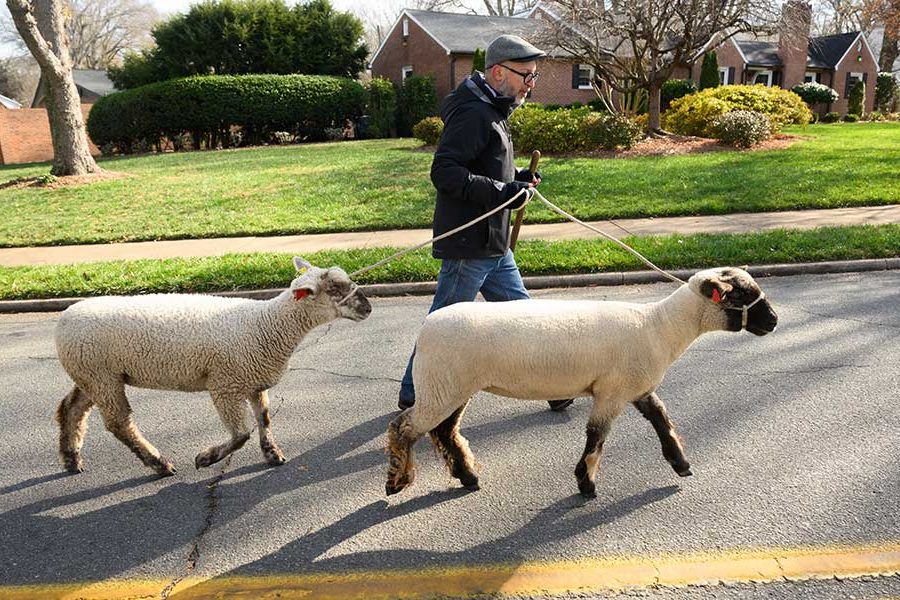Biologist Finds Seabird Kills in Order to Thrive
Taller than most seabirds, masked boobies live and breed in tropical oceans where they feed by making high-velocity dives. They also kill their own young.
In a new study subjecting Darwinâs evolutionary theories to some of their most rigorous scientific tests to date, biologist David Anderson at Wake Forest University found a curious irony: boobies kill in order to thrive.
“The common view of Darwinian natural selection is that it favors the evolution of parental interest in offspring,” said Anderson, a member of the Wake Forest faculty since 1992 and reviewer for the National Geographic Society, National Science Foundation and several journals. “Parents that care for their kids raise the most kids and spread their genes most rapidly. However, in masked boobies and some other animals, siblicide is an integral part of reproductive success. Siblings engage in lethal battles shortly after hatching from their eggs.”
Anderson said that parents are far from disinterested observers of the family conflict.
“Masked booby parents are actually facilitating and encouraging this early siblicide,setting up a contest between the older and younger chick that only one is going to survive and stacking the odds in favor of their eldest,” Anderson said. “In masked boobies, maximizing reproductive success is not about being caring and nurturing but making short-term sacrifices of their own offspring for long-term gain,” he said. “This is more complicated than most people think Darwin’s theory about reproduction in evolution is. The bottom line isn’t how many babies you have now, but the total number of healthy offspring over the long term.
“When you have more young in a brood than you can care for well, it may pay to pare off some young. These findings are an extreme example from nature of that point.”
Masked boobies lay two eggs. If both hatch, usually about six days apart, siblicide occurs about a day after the second egg hatches in the nest. The older chick forces the younger one out, leaving its tiny sibling prey to certain death from heat or patrolling mockingbirds.
The question for Anderson, who first began examining siblicide in 1984 among the boobies that nest on Isla Espanola, the Galapagosâ most southeastern island, was why. Why engage in a behavior that would seemingly condemn the species to extinction? Why lay two eggs if the goal was only one child?
“Siblicide demands an explanation because it’s close relatives killing each other,” Anderson said. “Getting back to Darwin, the question is how could you maximize long-term reproductive success this way?”
He found part of the answer in the boobies’ poor hatching rates. Masked boobies only hatch about 60 percent of their eggs, even under perfect conditions,unlike other species, which hatch about 90 percent of their eggs. An “insurance egg” hypothesis,that a second egg greatly increased the chances of reproductive success,turned out to be on target. By laying two eggs, boobies decreased their risk of total reproductive failure to about 16 percent.
But what about the violence and the collaboration between parent and child to eliminate the second-born chick? From 1992 to 1995, Anderson and the Wake Forest graduate students taking part in his National Science Foundation study compared masked boobies to a related species, the blue-footed booby. Blue-footed boobies only engage in siblicidal behavior during severe food shortages when the first-born bird drops below 75 percent of normal body weight.
Blue-footed booby chicks were put in masked booby nests and vice versa, to determine whether parents, or offspring, or both, controlled the siblicide. In masked booby chicks raised by blue-footed booby parents, siblicide happened in 80 percent of the nests, compared to the normal 100 percent when masked booby chicks are cared for by masked booby parents. About half of the blue-footed booby chicks killed their siblings when raised by masked booby adults. “The masked booby parents seem to be collaborating with the first chick to get rid of the second chick,” Anderson said.
Moreover, work by Andrea Schwandt, a Wake Forest graduate student working in Anderson’s Galapagos laboratory, suggests that masked booby parents even stand over their chicks to give the attacking bird more room to maneuver. The masked boobies’ nest, flatter than the blue-footed species, may also make the ejector’s job easier. In contrast, blue-footed booby parents squash their chicks down into their bowl-shaped nests.
Despite the evidence of collaboration between masked booby parents and their firstborn chick in siblicide, Anderson has not yet completed analyzing data to answer the ultimate question: the long-term effects on booby adults forced to raise two chicks.
But preliminary data clearly show a cost. “They show up at the colony in about the same frequency the second year, but are much less likely to breed,” said Anderson, who visits the Galapagos each fall to set up his research team’s camp, returns in July to close another season of data-gathering, and supervises the team through computer e-mail and satellite telephone.
“The parents are tuckered out from the year before,” Anderson said. “If the rest of our data show the same trend, then you would say that parents seem to maximize their long-term reproductive success by collaborating in the siblicide, because the effort required to raise two chicks at once is so high. The insurance value of the second egg is there, but once the first egg hatches, a second chick is a liability.
“Darwin may not have envisioned the siblicide scenario, but he would have been perfectly comfortable with these results.”
Categories: Research & Discovery, University Announcements
Media Contact
Wake Forest News
media@wfu.edu
336.758.5237



